Texas is a great place to live for most of the year. Texas yards are envied by people living elsewhere as they shine lively in the spring and fall and have flowers blooming all year long. However, selecting the perfect flowers to grow in Texas is more difficult than one might imagine. Some plants need a lot of attention, some are pest-prone, and many are just too complicated or slow-growing to be practical.
Despite all the benefits of living in Texas, one thing cannot be denied: it can get very hot, especially in the summer. Living in Texas means you should be prepared for extended periods of heat and drought. So, if you are a gardener or just love planting flowers around your home, below are the best flowers to plant in Texas that are guaranteed to survive the heat and intense climate changes in the Lone Star State.
17 Best Flowers to Plant in Texas
1. Hibiscus
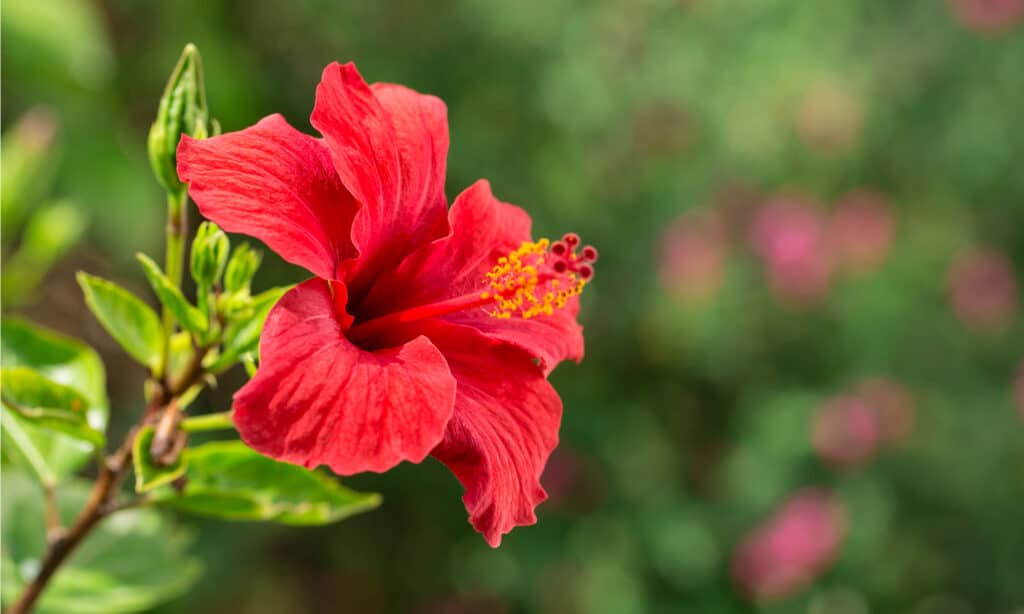
Hibiscus flowers require higher temperatures where there is adequate humidity for them to grow
©APCat/Shutterstock.com
The first image that comes to mind when you imagine a tropical rainforest is hibiscus blossoms. The Texas Star Hibiscus has large, solitary, scarlet flowers of three to four inches wide that are carried on stems of palmately lobed leaves with three to seven segments. They do require higher temperatures where there is adequate humidity for them to grow. As long as summertime temperatures don’t exceed 95°F (35°C), the hibiscus thrives.
2. Daisies
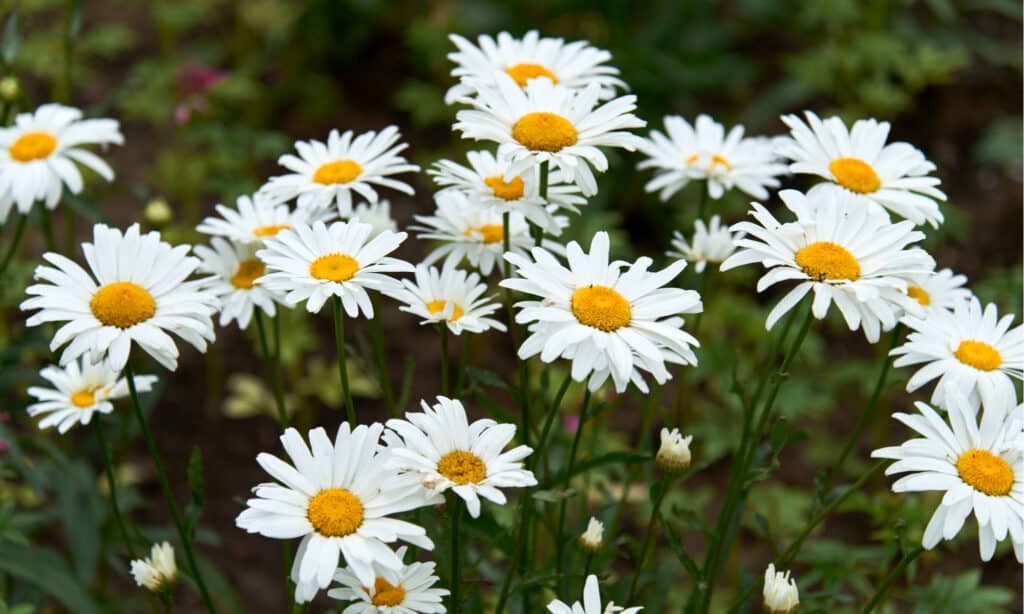
Although it doesn’t happen frequently, daisy plants fall prey to fungus and disease.
©Smyshliaeva Oksana/Shutterstock.com
Daisies are ideal for planting anywhere in your Texas yard because they thrive in higher temperatures and sunlight. Cold and wet weather frequently leads to an increase in disease and fungus. Although it doesn’t happen frequently, daisy plants fall prey to fungus and disease, which results in no blooms or the flower dies. Plant daisies in the spring and bulbs in the fall to see this lovely bloom return yearly with little to no upkeep.
3. Columbine
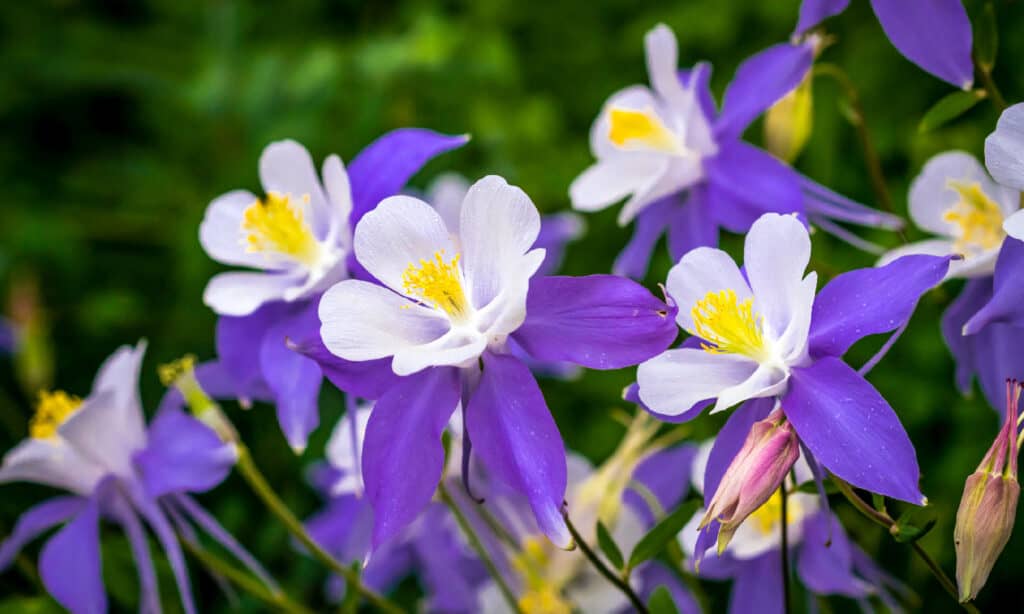
Columbines become dormant when there’s no water.
©iStock.com/tvirbickis
In the heat of Texas, both red and yellow columbines thrive, but they do best in wet, well-drained soil. When there is a lack of water in the summer, columbines frequently become dormant. Hummingbirds swarm to these blossoms in large numbers.
4. Salvia Farinacea
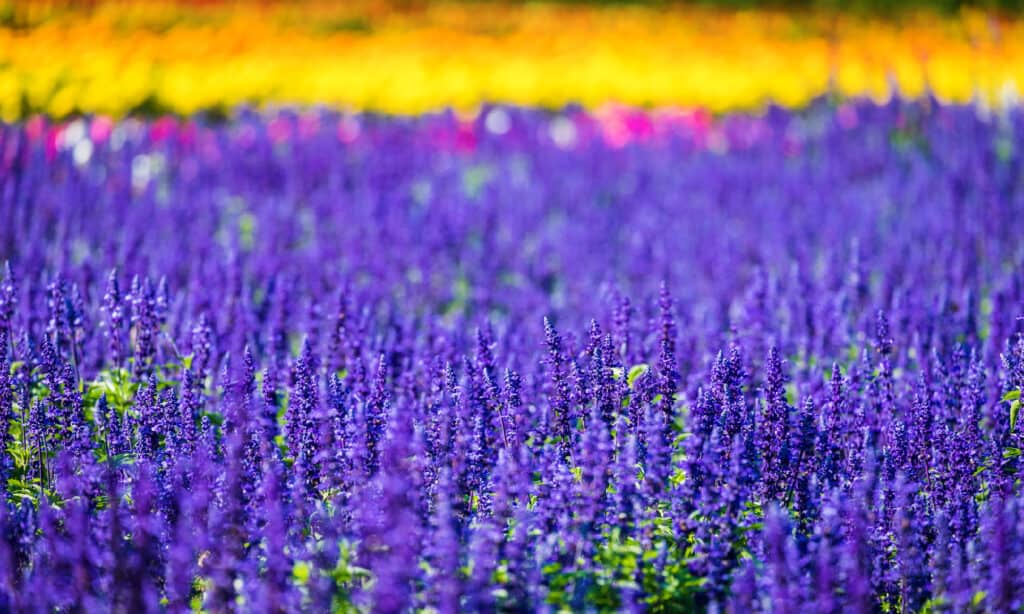
With proper care, Salvia farinacea can bloom consistently for up to five years.
©iStock.com/Biscut
Beautiful native Texas plant Salvia farinacea is simple to grow, draws hummingbirds and butterflies, is extremely drought-tolerant, and doesn’t lure in deer. It’s endemic to Texas and can grow from 2 to 3 feet tall. Its flowering spires are blue or purplish-blue. It originates from Texas and Mexico and resembles the well-known Texas bluebonnets morphologically. It’s a Texas Superstar known for its low maintenance requirements and ability to endure heat, drought, and humidity. Salvia farinacea can bloom consistently for up to five years with proper care.
5. Cape Plumbago
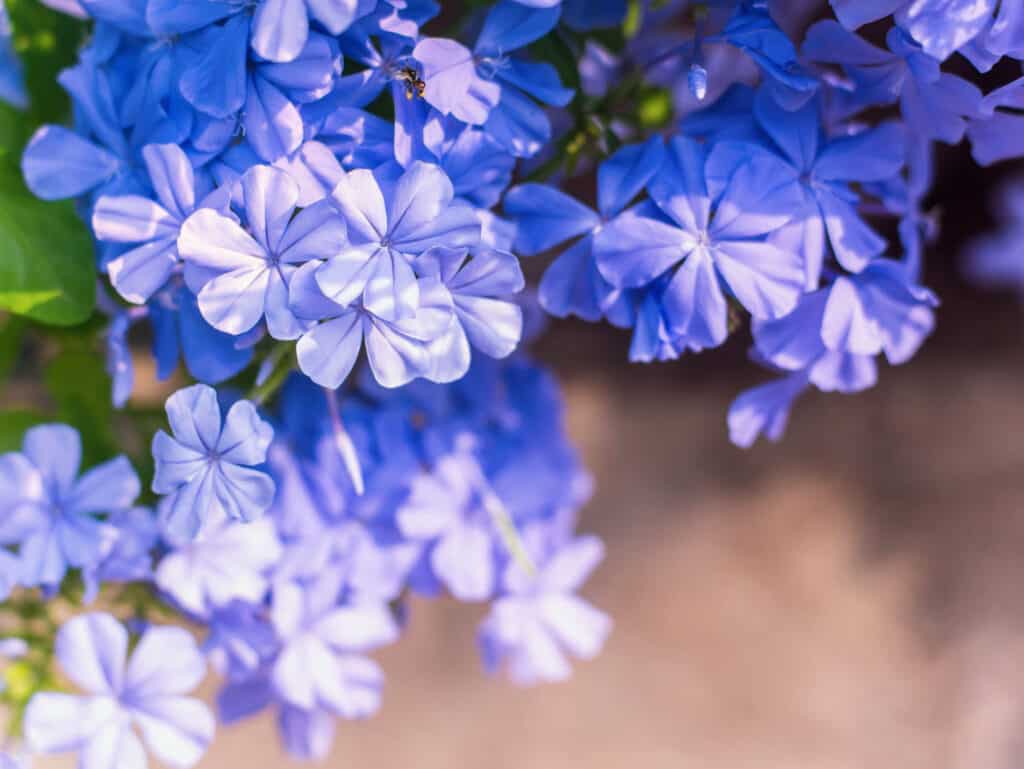
Cape plumbago, blooms abundantly from May until the first frost.
©iStock.com/hadkhanong_Thailand
One of Texas’ more well-known spring flowers, Cape plumbago, blooms abundantly from May until the first frost. The cape plumbago originates from warm, temperate, tropical regions, primarily South Africa. Despite being a sensitive perennial, Cape plumbago can withstand Texas’ midsummer heat and humidity. It thrives in environments with regular grass mowing, sandy, light soil with adequate drainage, and plenty of organic materials. The flowers have a phlox-like appearance and draw a variety of butterflies.
6. ‘John Fanick’ Phlox
‘John Fanick’ Phlox, a stunning bicolor with lavender-and-pink blooms, is named after a San Antonio nurseryman. It can stand both heat and humidity. Grow it in full sun to partial shade on moderately healthy, well-drained soil. Smaller phlox frequently succumb to powdery mildew disease, although the foliage’s waxy nature deters it. It can be grown in a small, 2-foot wide, 3-foot tall package.
7. Fall Aster

Fall aster flowers are at their greatest in the fall months.
©sasimoto/Shutterstock.com
A perennial with many branches, fall aster is bushy and performs best in sunny environments. In gloomy environments, it grows a little lean and is more likely to lodge or topple over. This natural shrub can withstand both sun and partial shade and has tiny, beautiful purple flowers. As the name implies, the plant’s flowers are at their greatest in the fall months, and it provides nectar. This plant needs little pruning in the spring and summer to maintain its compact shape.
8. Pentas
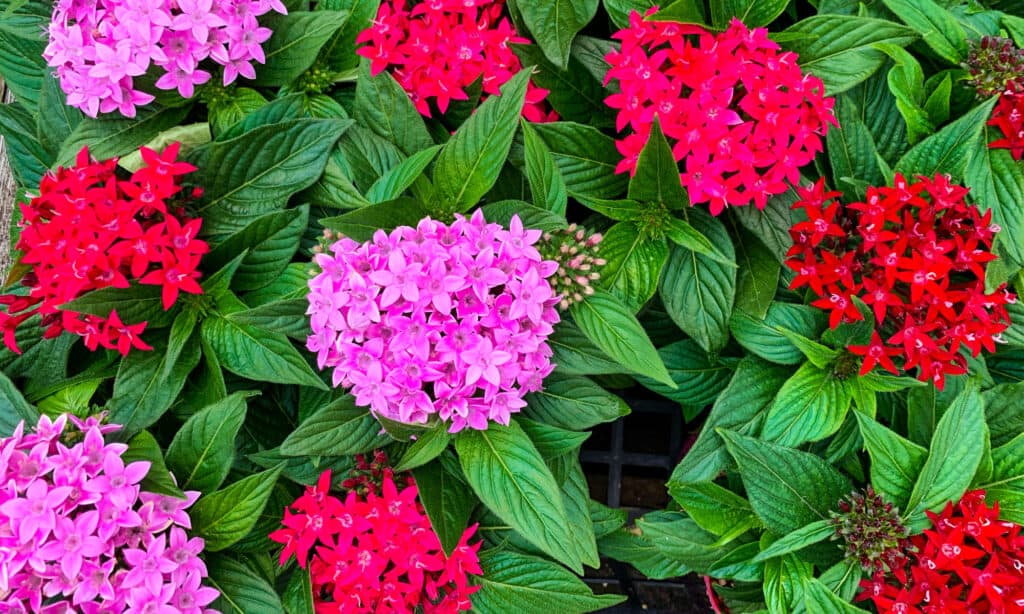
Pentas are warm-climate tropical blossoming plants native to
Africa
, Arabia, and Madagascar.
©Nokzd/Shutterstock.com
Pentas are recognized for their star-shaped flowers in various hues, including pink, red, purple, and more. They have lovely flowers that provide nectar that draws hummingbirds, birds, and bees. Despite appearing delicate, this plant can withstand heat. Pentas are warm-climate tropical blossoming plants native to Africa, Arabia, and Madagascar. These plants thrive under extremely bright light and are the best bedding and container plants for hot climates because of their remarkable summer durability, which allows them to withstand severe heat and humidity.
9. Sage
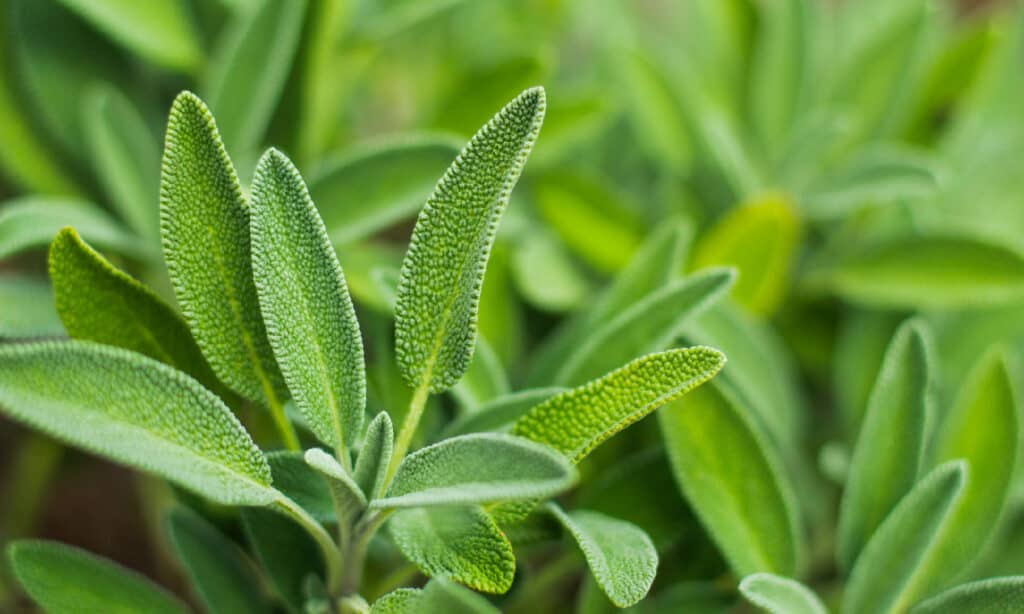
Sage plants are resistant to deer and rabbits.
©iStock.com/Bonnie McCann
The cultivars of Cherry (or Autumn), Cedar, Mealy Blue, Mexican Bush, Jerusalem, Majestic, San Luis, Russian, and Tropical Sage are incredibly tough and can easily tolerate the Texas heat. They do well in full sun, are resistant to deer and rabbits, and numerous varieties entice hummingbirds to your yard. After the first cold of the year, most species benefit from pruning.
10. Lantana

Lantana is a native of the tropics and thrives in moist, well-draining soil.
©Cathleen Wake Gorbatenko/Shutterstock.com
The lantana makes the ideal companion plant for outdoor activities with its luscious orange, yellow, pink, or lavender blossoms flooding your containers. Lantana prefers hot, humid weather because it is a native of the tropics and thrives in moist, well-draining soil but can overcome drought conditions. It blossoms all year long in close clusters of red, pink, orange, yellow, or white and flourishes in the light, particularly the afternoon sun. Since the flowers are enticing to butterflies, bees, and hummingbirds, they are perfect for growing along the edges of vegetable gardens.
11. Turk’s Cap
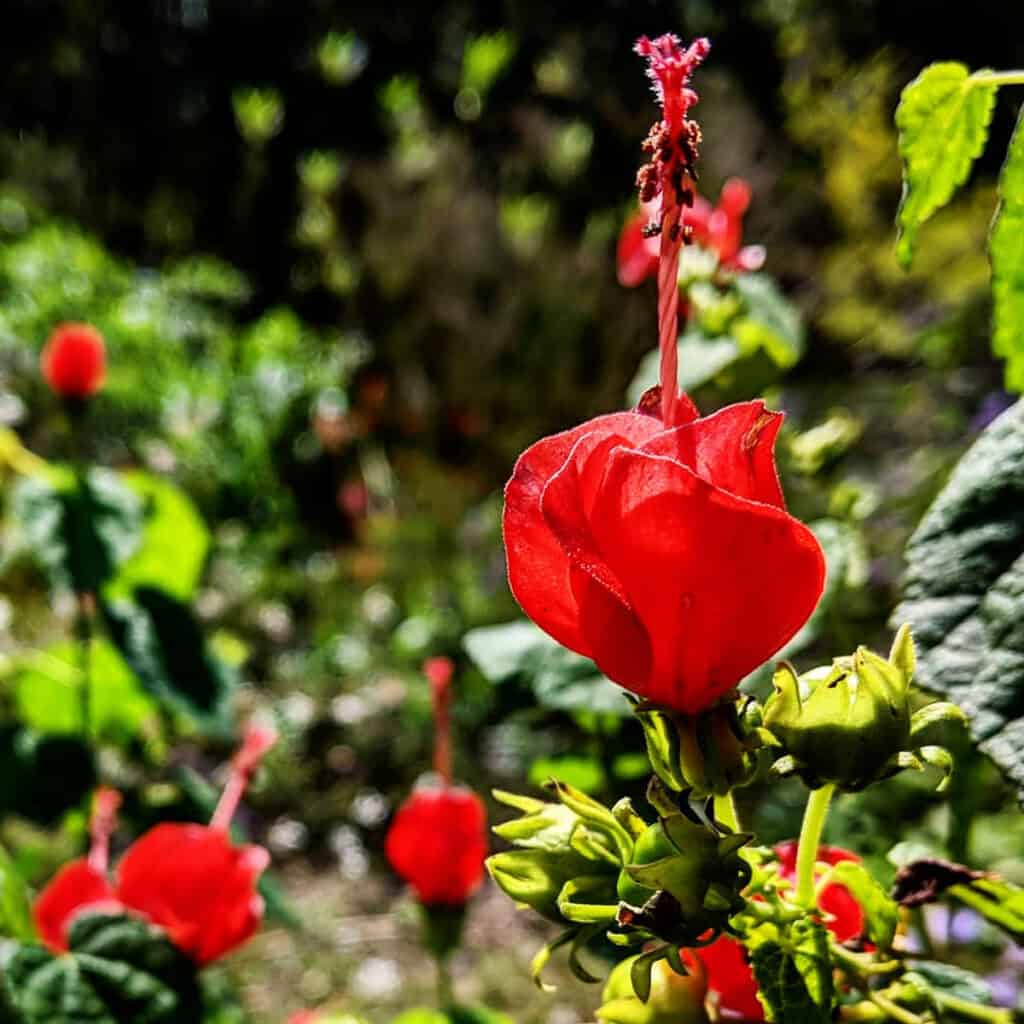
Once planted, Turk’s cap can withstand drought.
©iStock.com/Citysqwirl
Turk’s cap is a perennial that grows naturally in south Texas and is a superb ornamental for gloomy areas. It might not be hardy in Texas’ northern planting zones, but it could be grown there as an annual. Once planted, it can withstand drought. Hummingbirds and butterflies are drawn to the flowers because of their various colors, ranging from red to pink to white. It is a quick-growing shrub that can grow from three to six feet tall.
12. Petunia

Although they may tolerate some shade, petunias like full sunlight.
©iStock.com/skymoon13
Petunias are a wonderful annual flower that blooms until the beginning of November but truly does best in hot weather. You’ll notice more flowers as the temperature rises. On the tips of the one-foot stalks, trumpet-shaped, violet-blue flowers bloom, which are very showy due in part to the clouds of butterflies they draw. Although they may tolerate some shade, these perennials like full sunlight and will flower less in low-light conditions.
13. Zinnias
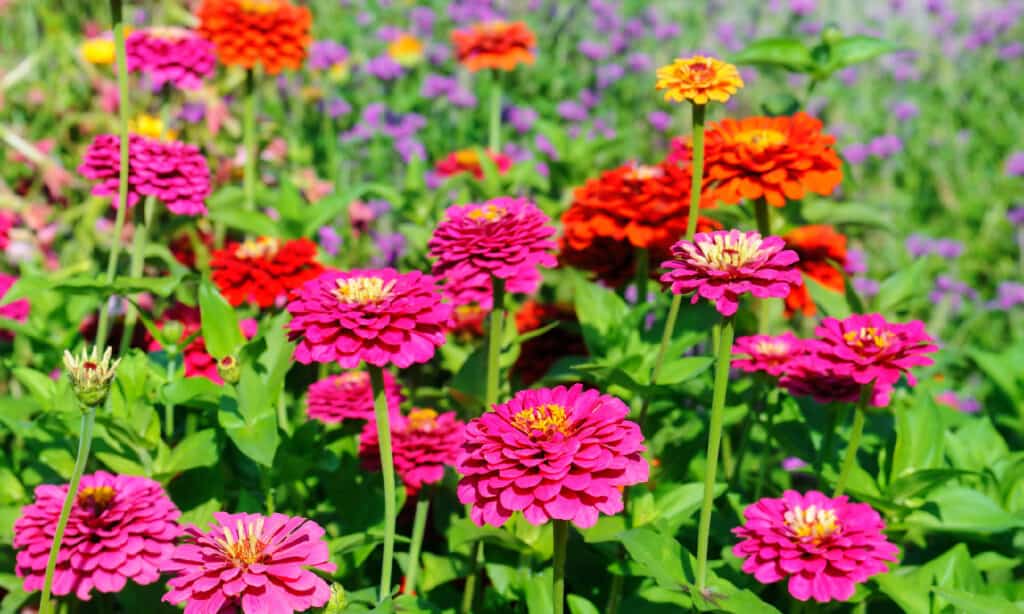
Zinnias can withstand heat and drought.
©iStock.com/AlinaMD
Zinnias are one of the few spring flowers that can be sown in early summer and still blossom and grow. However, you can plant them in the spring to give them a head start. The sun-loving, quick-blooming zinnias create daisy-like flowers with thick, emerald-green leaves. Our fellow pollinators love zinnias, and they can withstand heat and drought. Although they are lovely blossoms, the fungus can cause root rot if the soil becomes too damp.
14. Coneflowers

Coneflowers are low-maintenance perennials with vibrant flowers.
©iStock.com/Jasmina81
The ideal flower to grow anywhere in your yard, garden, or even within your home is coneflower. Coneflowers, also referred to as echinacea, are low-maintenance perennials with voluminous, vibrant flowers. They have blooms that come back yearly and can withstand heat and drought. They are a favorite of novice flower gardeners since they are simple to maintain and can be sown anywhere in the world. Coneflowers won’t be bothered by pests, drought, or rain, but would have trouble with insects. Your coneflowers will be harmed and even destroyed by Japanese beetles, aphids, and mites.
15. Purslane

Purslane is impervious to heat.
©iStock.com/hongquang09
Cup-shaped blossoms in vibrant pinks, reds, yellows and other colors can be seen on purslane. It’s a succulent that does well in hot, humid weather, making it the ideal flowering annual for Texas’ hot, humid weather. Small, succulent leaves on a dense, mounding growth habit characterize purslane. Purslane flourishes in the intense summer heat in contrast to lettuce, spinach, and other delicate greens that quickly bolt. Purslane is impervious to heat and drought and enjoys Texas summers.
16. Marigolds

Marigolds come in cherry orange and yellow hues, and bloom during the summer and fall.
©EQRoy/Shutterstock.com
Hardy marigolds tolerate heat well, are simple to cultivate in poor soil, and have lovely blooms. Annual marigolds are resilient and low-maintenance. Marigolds frequently appear on lists of the best warm-weather flowers, and it’s easy to see why: they’re time-honored, simple to grow, come in cherry orange and yellow hues, and bloom during the summer and fall while most plants are complaining about the heat. Marigolds are the ideal flower to grow for a longer flowering season if you experience early spring frosts or late fall frosts.
17. Daffodils

Daffodils can endure extreme heat, cold, garden pests, and occasionally illness and fungus.
©Susan Warren Photography/Shutterstock.com
Daffodils are one of the more understated bulbs that still thrive in the country’s hottest climates. Most likely, the toughest flower on this list is the daffodil. They can endure extreme heat, cold, garden pests, and occasionally illness and fungus. They will grow once you sow them year after year. So little maintenance is needed for these flowers. You don’t need to prune or deadhead the plant to encourage greater flowering. Additionally, it does well in both hot and cold climates!
Summary Of The 17 Best Flowers To Plant In Texas
| # | Plant | Best Place |
|---|---|---|
| 1 | Hibiscus | full sun |
| 2 | Daisies | full sun |
| 3 | Columbine | partial shade |
| 4 | Salvia Farinacea | full sun |
| 5 | Cape Plumbago | full sun but will tolerate some shade |
| 6 | ‘John Fanick’ Phlox | full sun to partial shade |
| 7 | Fall Aster | full sun to partial shade |
| 8 | Pentas | full sun |
| 9 | Sage | full sun |
| 10 | Lantana | full sun |
| 11 | Turk’s Cap | prefers full sun but does well in shade |
| 12 | Petunias | full sun |
| 13 | Zinnias | full sun |
| 14 | Coneflowers | full sun to partial shade |
| 15 | Purslane | full sun |
| 16 | Marigolds | full sun |
| 17 | Daffodils | full sun |
The photo featured at the top of this post is © sasimoto/Shutterstock.com
Sources
- Southern Botanical, Available here: https://southernbotanical.com/the-benchmark/five-tough-summer-plants-that-will-survive-the-texas-heat/
- ABC Blog, Available here: https://www.abchomeandcommercial.com/blog/heat-tolerant-plants-for-texas/
- Texas Highways, Available here: https://texashighways.com/wildflowers/wildflowers-of-texas/
Thank you for reading! Have some feedback for us? Contact the AZ Animals editorial team.






